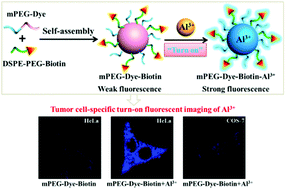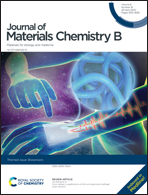Biotinylated and fluorophore-incorporated polymeric mixed micelles for tumor cell-specific turn-on fluorescence imaging of Al3+†
Abstract
Excessive amounts of Al3+ in the human body can cause adverse effects on immune function and induce several neurodegenerative disorders. So far, most of the reported fluorescent probes for Al3+ present some common drawbacks, such as low sensitivity and poor water solubility. In addition, a number of traditional fluorescent probes failed to image Al3+ in tumor cells due to the lack of tumor cell targeting capacity and cell penetrating abilities. To overcome these shortcomings, we constructed tumor-targeting fluorescent mixed nano-micelles (mPEG-Dye–Biotin) with an average particle size of 21 nm from an amphiphilic polymer containing a Schiff-base fluorescent unit (mPEG-Dye) and another amphiphilic polymer containing a tumor cell recognition ligand (DSPE–PEG–Biotin), through the co-self-assembly of both amphiphilic polymers in water using the film rehydration method. The as-prepared nanoprobe showed a highly sensitive and selective turn-on fluorescence response to Al3+ in aqueous solution with a low detection limit. MTT assay revealed the negligible cytotoxicity of the mPEG-Dye–Biotin nanoprobe to both HeLa cells and COS-7 cells, indicating the safety of mPEG-Dye–Biotin for biological applications. More importantly, the biotinylated nanoprobe showed better ability to enter biotin receptor-positive HeLa cells than that of the non-biotinylated micelle mPEG-Dye, which made it more suitable for imaging Al3+ in biotin receptor-positive tumor cells. This work provides a simple and general strategy to design a highly sensitive and tumor cell-specific metal ion nanoprobe, which can not only be applied in Al3+ imaging, but can also be extended to other ions or biomolecules by changing the incorporated fluorescent unit in the amphiphilic polymer.

- This article is part of the themed collection: Biosensors


 Please wait while we load your content...
Please wait while we load your content...